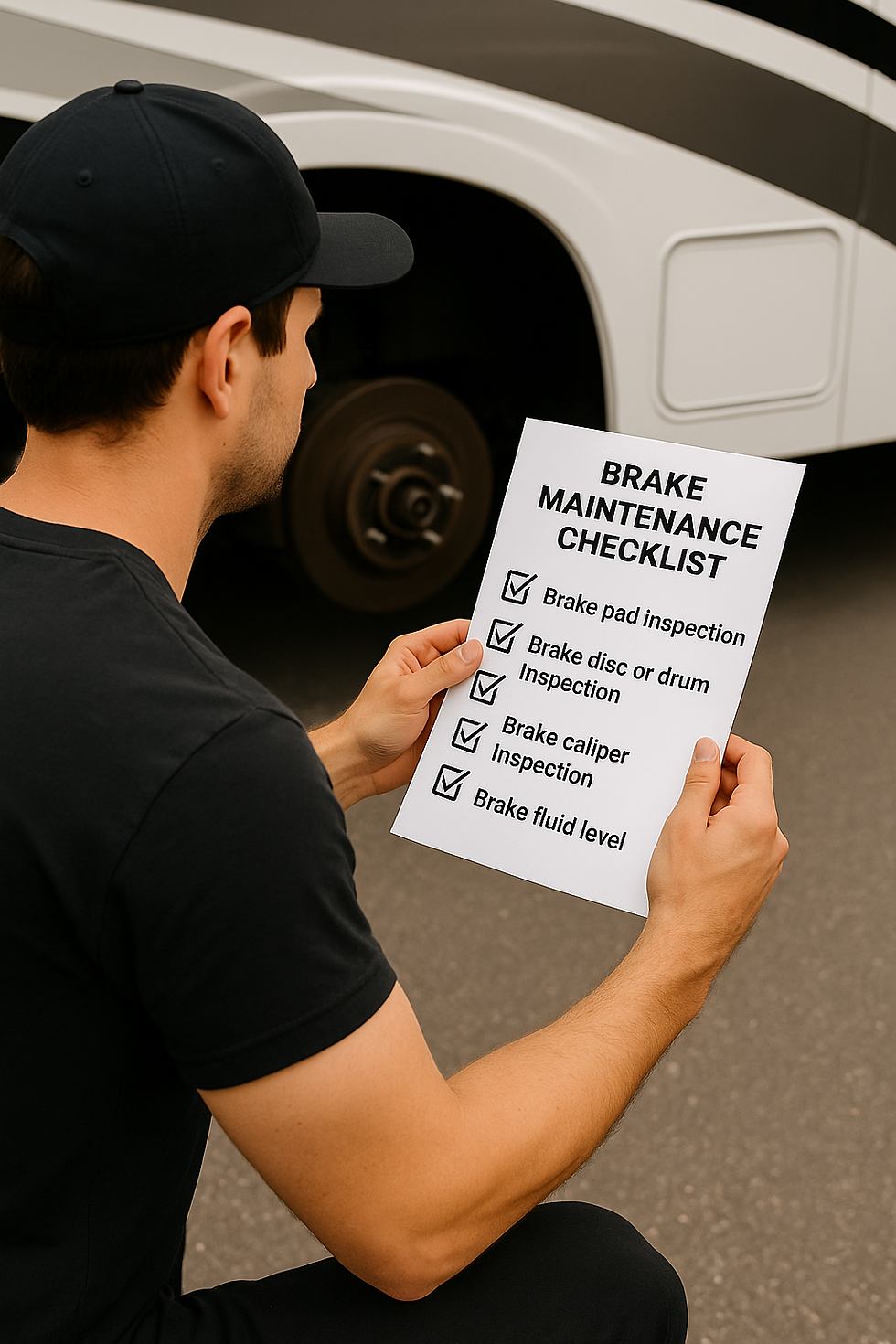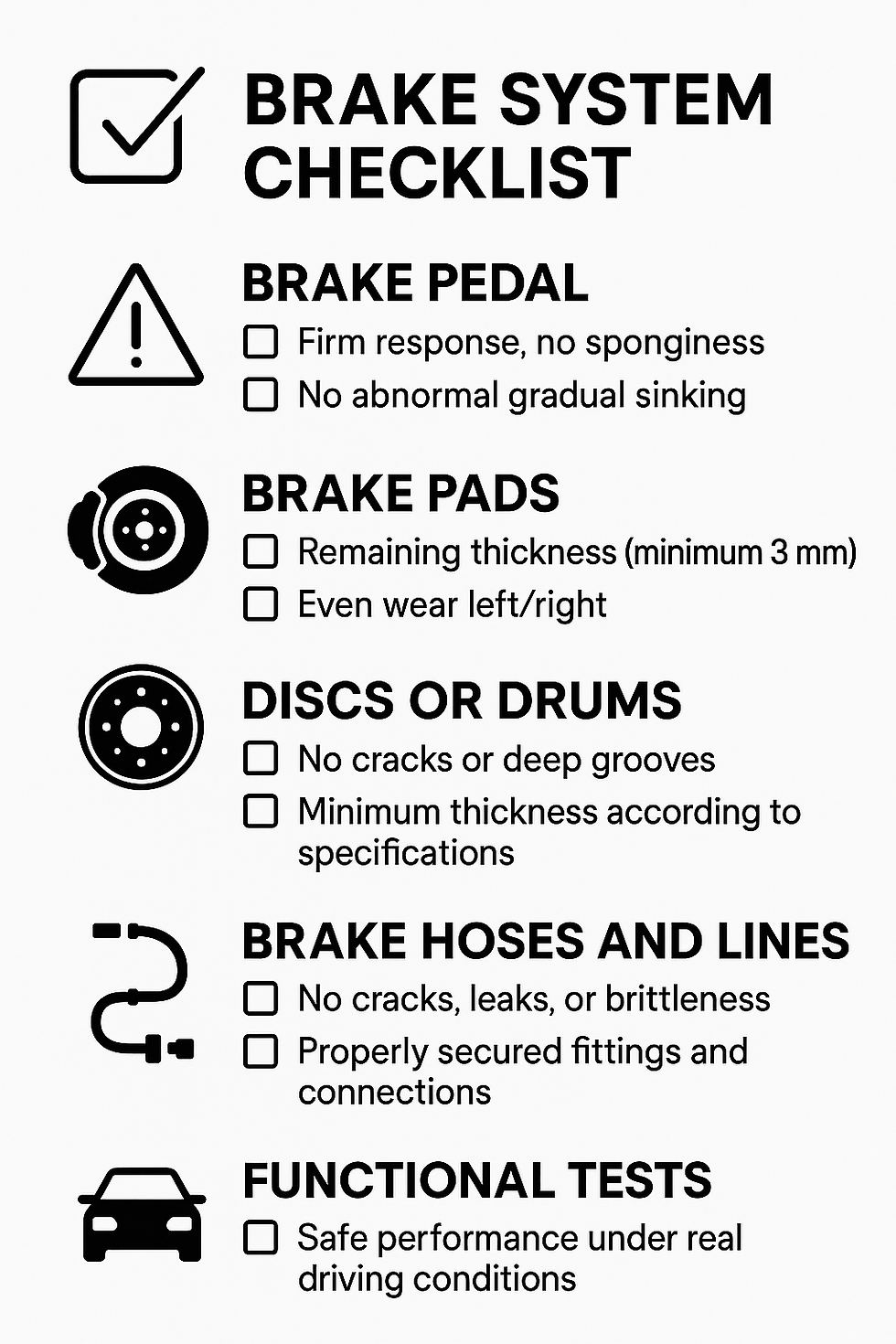Brake Maintenance Checklist: Essential for Your Vehicle’s Safety
- brouillettevincent
- Apr 27
- 4 min read

Brakes are among the most critical safety systems of any vehicle. Whether you are a professional driver, an RV enthusiast, or simply a cautious motorist, neglecting brake maintenance can lead not only to costly repairs but, more importantly, to serious accidents.
That’s why we offer you this complete and detailed brake maintenance checklist, designed to guide you through every essential inspection step, from visual checks to practical tests — including the recommended tools to have on hand.
Recommended Frequency: When Should You Inspect Your Vehicle’s Brakes?
Brake maintenance is essential to ensure your vehicle’s safety. It should never be left to chance, as brake system failure can have serious consequences. Knowing the key moments when an inspection is necessary is critical.
First, it is recommended to inspect the brakes every 20,000 kilometers (or approximately 12,000 miles), or according to the specific guidelines provided by the manufacturer. This frequency helps detect gradual wear of components and allows for timely intervention before problems arise.
Second, a preventive inspection before any major trip is strongly advised, especially for recreational vehicles (RVs), trucks, or heavily loaded vehicles. These conditions place additional stress on the braking system and demand extra attention.
Finally, at the first sign of unusual symptoms, such as squeaking noises, pedal vibrations, or longer stopping distances—an immediate inspection is crucial.
Following these best practices not only extends the life of your braking components but also ensures safe driving and protects all passengers onboard.
Visual and Physical Checks: What Your Eyes Can Already Tell You
A careful visual and physical inspection can often prevent costly repairs. Monitoring the brake system visually allows you to detect early signs of wear or malfunction before they become critical.
Start with the brake pads. If the remaining thickness is less than 3 mm, they need to be replaced. Uneven wear between the left and right sides may indicate deeper issues such as seized calipers or suspension misalignment.
Brake discs or drums should be free of cracks, deep grooves, or signs of overheating. Their thickness should be measured accurately using a caliper, following the manufacturer's specifications.
Brake calipers should be inspected for potential leaks and to ensure that the caliper slides move freely and smoothly.
Brake hoses must not show any cracks, leaks, or brittleness. Also verify that all fittings are secure and that no lines are kinked.
Finally, inspect the rigid brake lines: any signs of corrosion, leaks, or unstable mounting should be addressed immediately.
These simple yet critical checks ensure the reliability and safety of your braking system on the road.

Brake Fluid: A Critical but Often Overlooked Fluid
Often relegated to the background during maintenance, brake fluid plays a crucial role in the proper functioning of the braking system. Its particularity? It is hygroscopic, meaning it absorbs moisture from the air over time. This moisture absorption gradually reduces its effectiveness, increasing the risk of overheating and loss of braking performance during prolonged braking.
Several simple checks can help assess its condition. The fluid level in the reservoir should always be between the MIN and MAX markers. A low level may indicate a leak in the system or advanced brake pad wear.
The color of the fluid is another key indicator: clear fluid indicates good condition, while dark or cloudy fluid signals contamination and the need for replacement.
A boiling point test, performed with an electronic tester, measures the fluid’s heat resistance. A low boiling point could result in brake failure under heavy use.
Finally, a complete brake fluid flush is recommended every two years, unless the vehicle manufacturer specifies otherwise. This simple preventive maintenance step is essential for safe and reliable braking.
Functional Tests: Ensuring Safety in Real Conditions
After completing visual inspections and component checks, it is vital to perform functional tests under real driving conditions. These dynamic tests confirm that the entire braking system responds correctly and without anomalies before hitting the road.
Start by testing the brake pedal. It should offer firm, immediate, and consistent resistance. A pedal that slowly sinks or feels spongy may indicate air in the system, low brake fluid, or a more serious issue such as a hydraulic leak.
Next, check the parking brake (handbrake). It must firmly hold the vehicle in place on an incline. If the lever requires an excessive number of clicks to engage, mechanical adjustment is likely needed.
Pay attention to any unusual noises during braking. Squealing, grinding sounds, or vibrations felt in the pedal or steering wheel are signs of wear or deformation. Do not take any chances: have the vehicle inspected immediately by a professional.
Finally, perform a road test on a safe, open stretch. Apply firm braking in a straight line, the vehicle should maintain a straight trajectory without pulling to one side. Any deviation indicates a braking imbalance or a suspension issue.
These simple but crucial tests ensure efficient, stable, and safe braking, especially before long trips or in demanding driving conditions.
Useful Tools and Products: Your Home Inspection Kit
To carry out a complete brake inspection yourself, here’s a list of recommended tools:
Wire brush: For cleaning contact surfaces.
Brake cleaner (aerosol): Essential for removing residues without contaminating braking surfaces.
Special slide pin grease: Improves caliper movement and prevents seizing.
Torque wrench: To correctly apply the specified torque to bolts.
Brake fluid tester: Quickly checks the fluid’s boiling point.
Jack and safety stands: Always properly stabilize the vehicle before working underneath the chassis.
Memo Space: Tracking That Prevents Trouble
Keep a written record of your inspections:
Date of last inspection: __________________________
Next scheduled inspection: __________________________
Comments / Notes: __________________________
This tracking helps demonstrate regular maintenance, providing peace of mind and proving valuable when selling your vehicle or during official inspections.
In Summary
The brake maintenance checklist is a simple yet highly effective tool for keeping your vehicle’s braking system in excellent condition. It helps you to:
Prevent dangerous breakdowns
Reduce long-term repair costs
Drive with confidence, whether for daily commutes or long journeys
Adopt this routine every 20,000 kilometers (or about 12,000 miles) or before any major trip, and you’ll drive with greater peace of mind — knowing your brakes are ready for the road ahead.



Comments